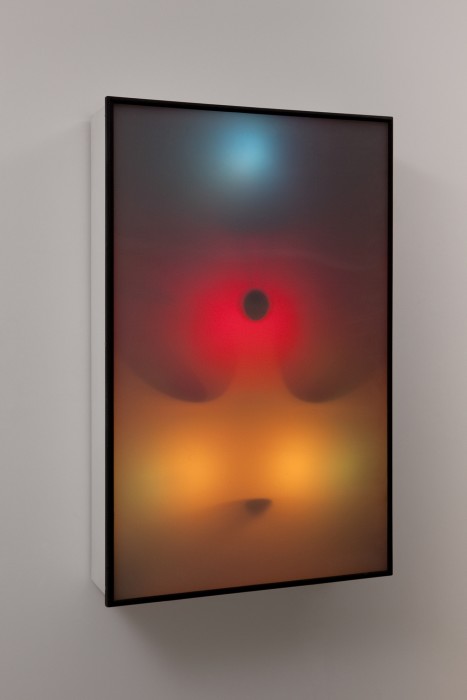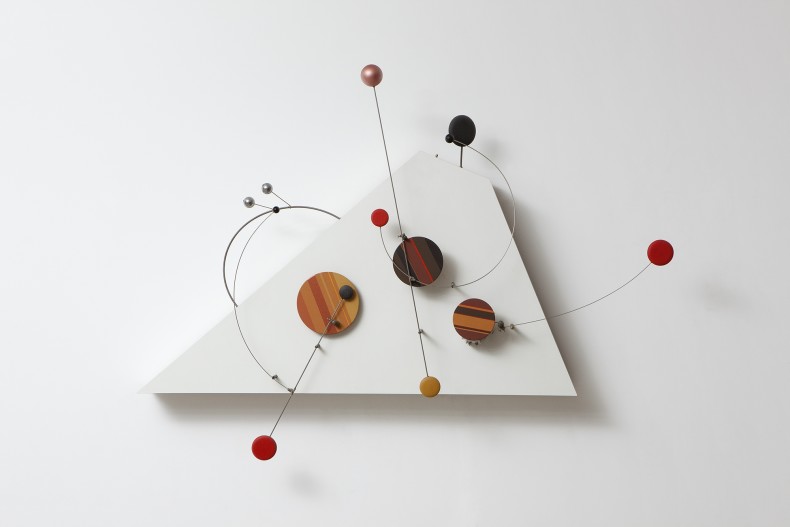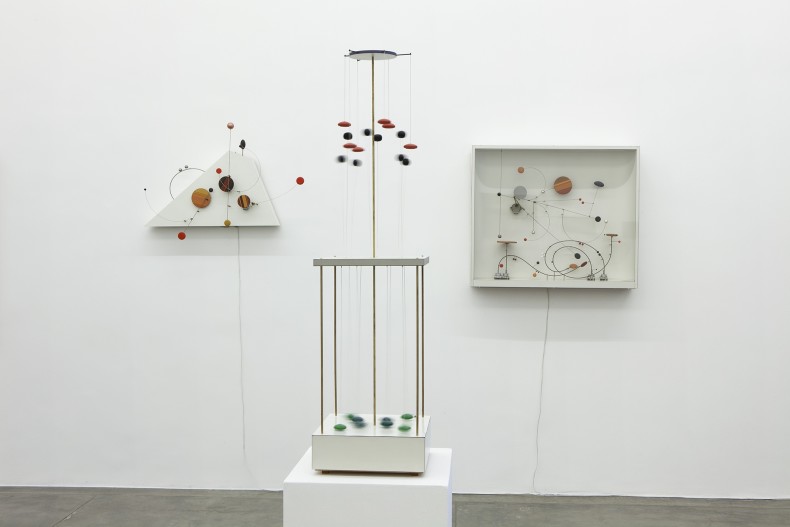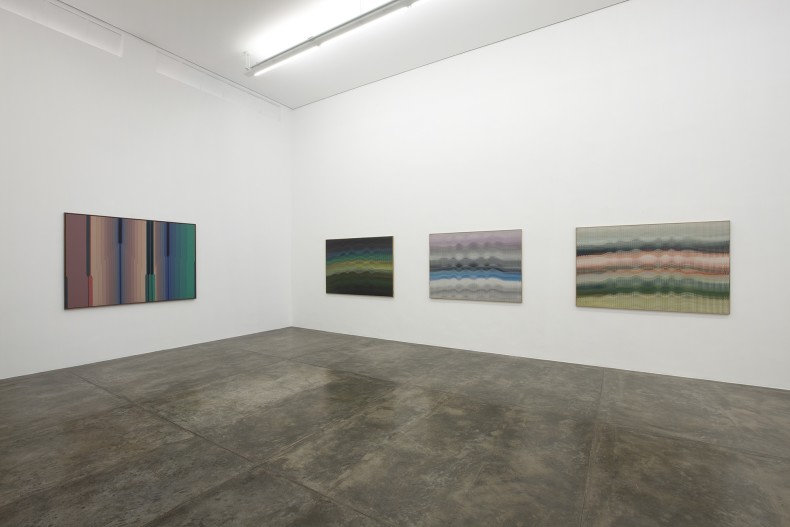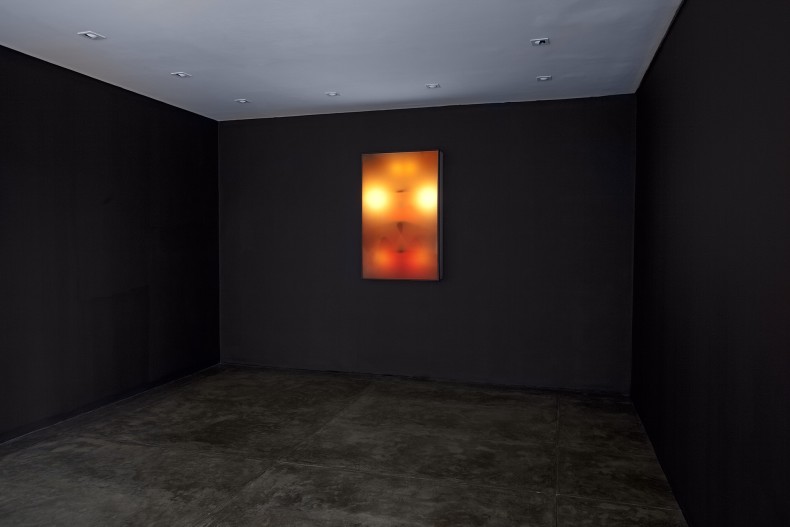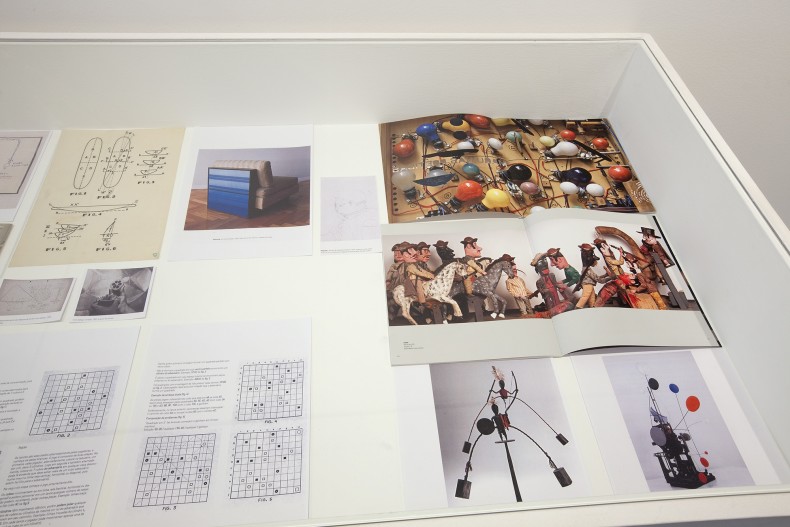Galeria Nara Roesler is pleased to announce Abraham Palatnik's new solo exhibition at the gallery. Curated by Frederico Morais, the exhibition is organized chronologically, mapping over 60 years of artistic production, spanning from early series such as Kinechromatic Devices, Kinetic Objects, Progressive Reliefs, Ludic Objects, to more recent works like the W series and Duco on paperboard paintings.
kinechromatic devices
Between 1949 and 1950, he built his first two kinechromatic devices.
Blue and Purple in First Movement was shown at the 1st São Paulo Biennial (1951). It contained 600 meters of electric wires linking 101 lamps of various voltages, rotating several cylinders at varying speeds.
To critic Mario Pedrosa, who coined the term kinechromatic, it was the first attempt, in Brazil, to create Moholy Nagy’s artistic utopia. It consisted of creating “frescoes of light destined to animate buildings or walls with the plastic dynamism of artificial light according to the artist’s will and inspiration”.
Up until 1983, Palatnik had created 33 kinechromatic devices exhibited in seven editions of the São Paulo Biennial – from 1951 to 1963 –, as well as in Venice (1964) and Cordoba (1966) Biennials, in individual and group shows both in Europe and in the United States. His eighth device, a 4-minute sequence of green-orange images, was exhibited at the Rio de Janeiro Museum of Modern Art in 1960. It presented a series of technical innovations, such as a miniaturized control center, the reduction of both the electrical wiring (to 60 meters) and the number of lamps (to 51), as well as the introduction of a central of automatic control.
With his kinechromatic devices, Palatnik, besides anticipating the constructive current – which emerged with the creation of Grupo Ruptura (São Paulo, 1952) and Grupo Frente (Rio de Janeiro, 1954) and established itself with Concretism (1956) and Neo-Concretism (1969) – was the founder of the technological movement in Brazilian art.
At the Venice Biennial, they were considered cutting-edge kinetic art in terms of the binomial light-motion. Art critic Juergen Morschel wrote in an article on Palatnik’s 1965 solo show at the Saint Gallen Museum, in Swizertland, that he “does not execute objects, but rather stages events” and defined him as a “regisseur”. Frank Popper, in his introductory text for the show Kunst-Licht-Kunst that took place in 1966, at the Eindhoven Art Museum, Holland, made reference to Palatnik’s “luminous mobiles”, highlighting the “poetic vein” in his research. The following year, he confirmed Palatnik’s pioneer role in the field of light and motion research in a synoptic table contained in his book Naissance de l’Art Cinetique. Pierre Cabanne and Pierre Restany also reaffirmed in their book, entitled L’Avant-Garde au XXe Siècle (1969), Palatnik’s pioneer role regarding both Frank Malina’s “lumidynes” and Nicholas Shoeffer’s research on spatial dynamics. Tomás Maldonado, leader of the Argentine concrete-inventionists, saluted his Brazilian colleague as “the most important precursor of the last return to the aesthetics of light and movement”. Mari Carmen Ramírez, curator of the 2001 monumental show Heterotopias – Medio Siglo Sin-Lugar 1918-1968, which took place at the Reina Sofia Museum, Madrid, was the last prominent art critic to confirm Palatnik’s achievement.
paintings on glass
In 1953, Palatnik participated in the 1st National Abstract Art Exhibition, held at Quitandinha Hotel, in the Brazilian city of Petrópolis. It contained paintings on glass combined with incisions made on painted matter. A series of precise lines, even when slightly undulating, gravitated on the surface or were overlaid, forming a horizontal sequence of stripes, which in both cases did not affect the flat feature of the work.
Or in his 1954 work Sequência com intervalos (Sequence with intervals), in which he sought a more sensitive dialogue between color and line, creating unsuspected depths. Palatnik attached these paintings on glass to the back of armchairs made out of Brazilian rosewood, foam and fabric he had created. They were exhibited in four Grupo Frente shows, in 1954 and 1955.
magnetic fields
Palatnik did not take part in Neoconcretism; however he did absorb some of its principles, such as the participation of the spectator in the development of the artwork. Therefore, after the kinechromatic devices, in 1959, the artist created some works in which he explored the aesthetic possibilities of magnetic fields. Some of them included the ludic participation of the spectator. In one of these works, entitled Mobilidade IV (Mobility IV), wooden balls were silently set in motion by an electromagnet.
perfect square
In 1962, Palatnik designed and patented the game he called Quadrado Perfeito (Perfect Square), which was exhibited for the first time at the Barcinski Gallery, in Rio de Janeiro, and nine years later, at the show Arte Programatta e Cinética, in Milan. It is a game based on the shift of pieces on a board similar to a chess board. However, there are no pieces to be captured or a checkmate, or even an established initial position. His game demands more perception than reasoning.
The game became a substantial portion of Abraham Palatnik’s work, acquiring various shapes according to the pre-established programs. In kinechromatic devices, there are movements being endlessly done and undone, as well as colors that appear and disappear. In kinetic objects, there is a game of symmetry and asymmetry that prolong silent movements. In the ludic object, the player wins when the original geometric shape is recovered. In the above-mentioned game, one wins when the perfect square is perceived. An artist such as Palatnik is the perfect illustration of the homo ludens Huizinga talks about.
progressive reliefs: wood
Also in 1962, he began to create a series of “progressive reliefs”, each one identified according to the material used in it. The first to be chosen was wood.
When visiting a carpenter’s shop, Palatnik observed that the fragments of logs, cut lengthwise, scattered on the floor were a spontaneous information on nature. The progression of knots is an inevitable record of growth situations. It is important to note that nature itself creates visual patterns on the wood: tonalities, graphisms, stains. He, then, decided to establish an aesthetic discipline in these shapes, or natural patterns, aiming at “accessing the senses of people, activating their perception.”
Palatnik talked about this issue in an interview he gave me (“Palatnik, artist and inventor: Art must not convey messages, it must have a life of its own”. O Globo., 1981) and said: “My role as an artist is to discipline the chaos regarding information. In the universe, information is usually hidden and disguised amid disorder. The mechanisms of perception and of intuition are necessary to make them emerge. This is the “surprise” I’ve been interested in. The exchange process starts and, through the appropriate technology, I try to discipline information”.
In his first works, the main concern was to emphasize the idea of progression in a horizontal-undulating rhythm, which, by covering the entire bi-dimensional plane, suggests a virtual expansion beyond the edges of the frame. Later, he developed works in which the progression is partially substituted, or rather attached to the idea of symmetry to the extent that the pieces of wood form certain nuclei or areas/stains that are symmetrically opposed to one another.
kinetic objects
Palatnik built his first “kinetic objects” – made of metallic rods or wires equipped, in their extremities, with wooden discs painted of various colors as well as plates that moved slowly and silently, powered by clockwork and, in some cases, by electromagnets. There is only movement in it. Kinetic objects are related to sculpture and drawing. Kinechromatic devices are related to painting and cinema. In the devices, the mechanical or electrical gear is invisible, which reinforces the sensation of pictorial animation. In kinetic objects, it is visible – it is part of the visual field –, which indicates that Palatnik seeks to give the mechanism an aesthetical dimension. In the devices, the continuous metamorphosis of shapes and colors – plastic dynamism – generates a kinesthetic effect. In the objects, motion generates fascination.
Devices and objects are art-creating machines and were built with the same rigor and logical spirit, but the first ones suggest more coordination and control. The objects seem more spontaneous, as if fortune intervened. It is certain that kinetic objects are set in motion by clockwork or electromagnets, but the spirit that animates them is that of the mobile, which is also a machine, but a machine that is set in motion by a natural source of energy, which confers freshness, lightness and lyricism.
ludic object
In 1965, Palatnik resumed his research on magnetic fields by creating a ludic object, which consisted of placing geometric shapes of different colors on a round glass base. They are set in motion by the viewer through a magnetized stick. It is important to note that Palatnik uses the positive and negative poles of the magnet to attract or repel the geometric shapes that form the fragments of a larger structure, which will be set up by the viewer-participant. It is, at the limit of interpretation, a game.
progressive reliefs: cardboard
As of 1968, Palatnik began to use duplex paperboard to build his progressive reliefs. But instead of using its surface, he piled up several pieces, creating a cluster whose top was cut off afterwards. To do so, he used a double-bladed device. His reliefs, which had different depths, resulted in optical structures. Light passes through its interstices, creating partially illuminated areas that seem to open and close according to the movement of the viewer. In his reliefs, Palatnik explores the excess and the visual splendor, avoiding emptiness, which recalls the 18th century Baroque churches. A sacred element emerges in these reliefs and this became more evident when he replaced the paperboard for golden metal.
rotational object
In 1975, Palatnik invented what he called Rotational Object – a 12 x 2.5 x 0.8-cm piece made out of polyester resin that, as a result of a small distortion in one of its sides, inverts its rotation. The user gives the impulse on a horizontal, flat and hard surface and the piece, after spinning clockwise, responds by spinning on the opposite direction.
progressive reliefs: strings
In the following decades, Palatnik used three new materials: in the 1970s, he used polyester resin; in the 1980s, strings on canvas; in the 1990s, a plaster and glue compound. With the latter, which was applied onto the canvas with a tube whose mouthpiece served as paintbrush, the artist filled the space with a vibrant and colorful graphism that, nonetheless, maintained its progressive feature. In the progressions with polyester resin, he primarily explored the transparency of the material.
In 1981, during the first exhibition of the progressions made of strings on acrylic-painted canvases, Palatnik said it was “an attempt to organize the surface differently from regular procedures, introducing a dynamics through color”. I would like to add: a dynamics through color and line. Some works of the series are actually composed only of strings covered with the same white color that was used in other paintings. And by using only white color, Palatnik reinforced the linear structure that tensions the optical-kinetic rhythms, which is a constant element in all his work. However, differently from the progressions built with pieces of Brazilian rosewood – which tend to expand horizontally as if they were an abstract Muybridge –, the impulse in the string progressions is vertical, as if he wanted to express simultaneously the chromatic sonority of Scriabin’s luminous keyboard and the ascending drive of the columns that grow just like forests inside gothic cathedrals.
duco on paperboard paintings (1988)
Always avoiding the use of paintbrush and pigments, Palatnik created in 1988 a series of duco on paperboard paintings, which were later glued to wooden fiberboard. This industrial paint had already been used by some Grupo Frente members, such as Ivan Serpa, because it suits better the needs of a geometric painting, with pure and flat colors. It is a painting that is not contaminated by the subjectivity of the painter. The ten 37.5 x 37.5-cm paintings that comprise the series were all put in a wooden box as if they were a collection or a portable museum. Whereas the progressions are seen as the artist’s moment of a Baroque expansion, this series may be seen as an ‘interregnum’ of concrete painting.
cracol
In 1988 I coordinated, under the request of the Rio de Janeiro State Tourism Department, a contest aimed at choosing an underwater sculpture project to be set up in Angra dos Reis. I invited Abraham Palatnik to take part in it. Since he was used to face all kinds of challenges, he accepted with enthusiasm my unusual invitation. He designed a sculpture that was not to be simply immersed in the sea; it was actually the proposal of a “floating meeting” between divers and the work. Following the dynamics of the sculpture, the diver would be able to explore it inside and outside and have a sensorial and ludic experience. The work was designed to be built with shipbuilding steel plates, which is ecologically harmless to the underwater fauna and flora. Combining the spiral shape of the sculpture with the words caracol [snail] and cracaI [barnacle], creatures that would eventually cling to the surface of the piece, Palatnik called it Cracol. None of the projects that were presented, including the winner, was carried out. It’s a pity.
w series
Around the year 2004, Abraham Palatnik began to create a new series whose name was simply W. At first sight, it may seem to be a sequel to his progressive reliefs. And it actually is. But it goes beyond by proposing a discussion on the activation of the support, on its materiality, regarding the abstract and/or figurative occupation of the surface.
Nara Roesler was the first gallery to exhibit the works of that new series. I examined them in the text I wrote for the catalogue of the show, which took place from December 2004 to January 2005. I have already said, more than once, that Palatnik is an inventive artist who does not settle for simply getting inspiration from the heritage of art history and always brings innovation to it. And he continued to be like that, even when, after rushed interpretations, many saw his works for the Progressive Reliefs series as a return to traditional painting, which he had abandoned for good after seeing the remarkable works done by schizophrenic artists of the Engenho de Dentro Psichiatric Hospital. When he began to create the progressive relief series, in 1962, he said he had resumed the bi-dimensionality of the plane to create what he defined as a “discipline of the surface”. He, then, discarded, not only the figure, but everything traditionally associated with the practice of painting: easel, paintbrush, paint tubes, preparatory sketches, etc.
Below, I reproduce what I wrote about this other Palatnik invention. The obsession with content was one of the arguments used to criticize iconology, which was defined by Erwin Panofsky as a field within art history that studies the theme by opposing it to form. Well, a painting is comprised of two inter-related realities: a material support and a surface, which the painter fills with figures, landscapes, objects or shapes. Throughout the centuries, only the surface, as receptacle of the image, has been studied and valued. Some contemporary artists began to develop a work intending to decompose the material elements of the painting, which determined the “ruin of the image” resulting from the destruction of the illusory space. In other words, the intention of these artists was to replace iconology with “materiology”. Or, as Jean Clair said: “the painting disappears as place of mise-en-scène and re-emerges in its physicality as support and surface. The work of art is no longer seen as the object of knowledge, but as an object for knowledge”.
The practice developed by Palatnik to create his new works is similar to that of some members of the French group Suport/Surface, but it had different aims, which converge to his body of work. Actually, he began by applying acrylic paint on wood, creating different areas of color. Then, the painted support was laser-sliced and the strips were used to create new visual structures. The lines resulting from the combination of the wooden strips reactivate color, which makes the surface dynamic. A previously established program associates horizontal progression and vertical shift. With his kinetic objects, Palatnik brought to the foreground the materiality of the mechanics of the work, which, in terms of beauty, is equal to the visual effects. In the W series, support and surface constitute an indissoluble unit.
babassu-coconut and fishmeal
Palatnik has invented and patented several industrial mechanisms and the two previously-mentioned games. A central concern that used to affect the economy in certain regions of Northeastern Brazil was how to open babassu palm coconut to extract its seeds, which would be later transformed in oil. In 1952, after six months of research, he was able to create a machine that could open the coconut without breaking the seed. In 1968, he designed devices to optimize fishmeal production. That same year, he found a cheaper and less polluting solution to re-pack a specific powder that was used in the making of dental cement. For several years, he used his talent to create and make decorative objects (polyester animals), which were exported to 14 European and Asian countries, and to make his art. “All my industrial inventions were made after the kinechromatic device”, he told me during the same interview. In one of his rare written texts, Palatnik affirmed that “To invent something one must have an anti-conventional behavior. I think manufacturers should consult visual artists because they have a perceptive potential that may solve innumerous problems”.
In a text whose title and date I can’t recall, Mário Pedrosa wrote: “The revolutionary artists of our days will either be ‘inventors’ or will not be; but inventors like the inventors from ancient times who, inspired by the naïveté of children, created by destroying their toys and, nurtured with pure imagination, forgot about themselves in the eternal search for the philosopher's stone, in the errant streams where, today, science and magic are mistaken for one another”.
His studio, set up in two small rooms in his apartment in Urca, does not look like the spotless modern technological environments; there are no computers or any other sophisticated electronic devices. It is actually full of boxes and containers with nails, clockworks, drills, circular saws, magnifying glasses, sanders, welding machines, pincers, etc. In this low-tech environment he is, truly, an artist-craftsman, but capable of performing miracles with his rudimentary equipment; and of moving us with his works.
